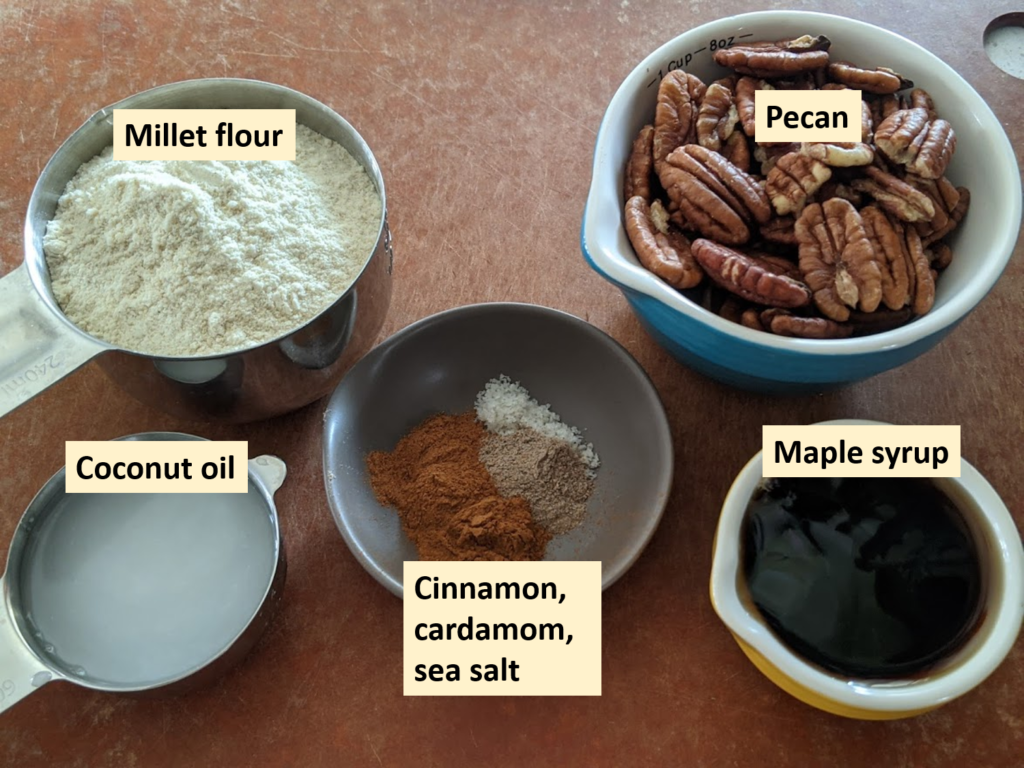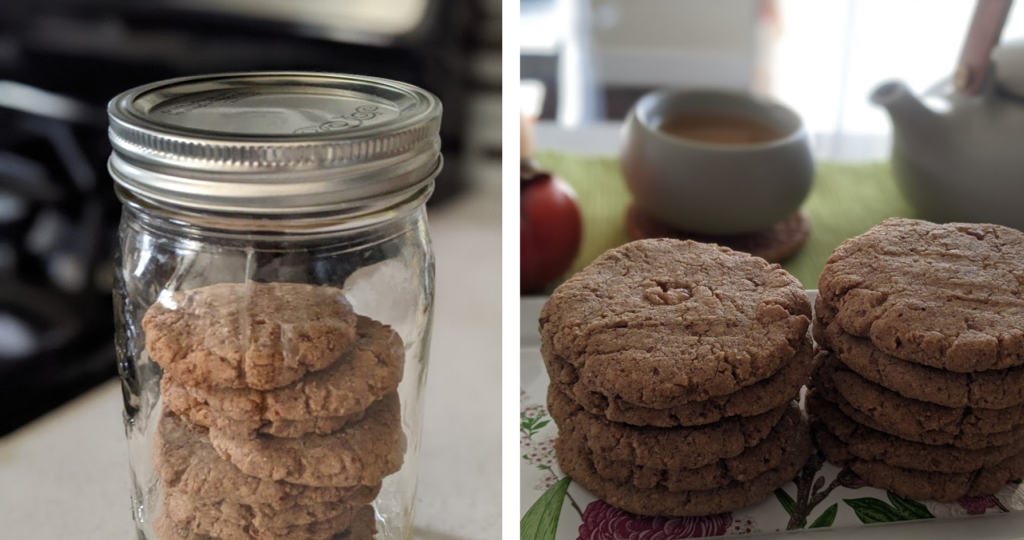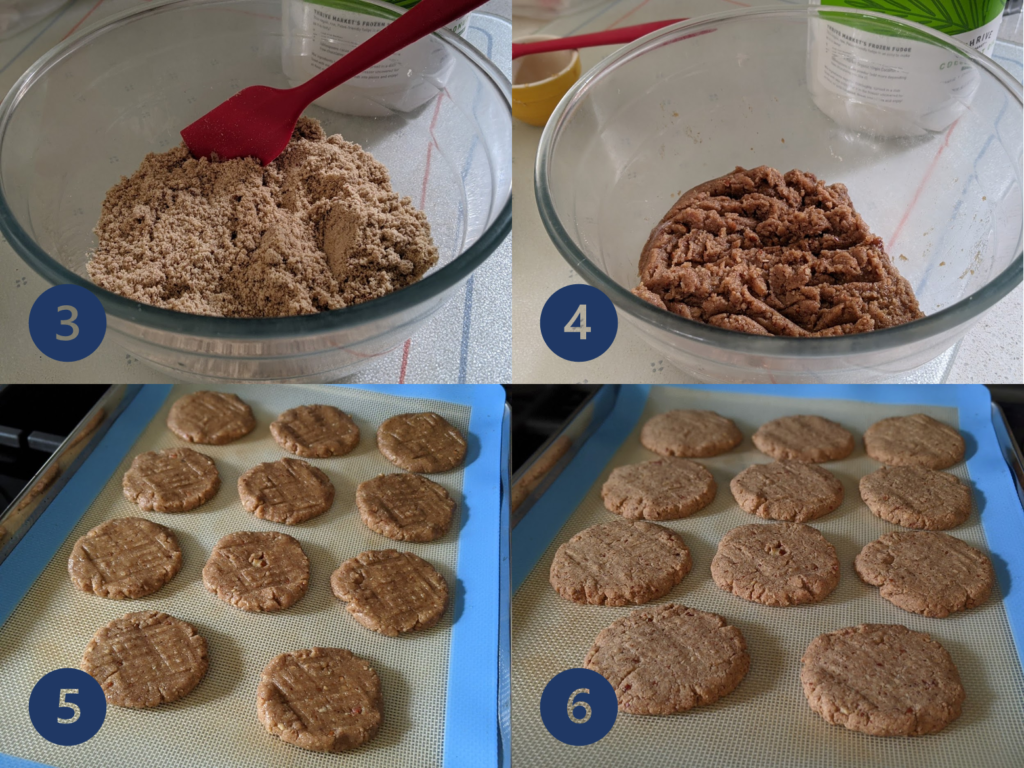Join our mailing list to receive the latest health tips and updates.
You have Successfully Subscribed!
Easy Maple Pecan Cookies (4 Ingredients + Spices, GF, Vegan)

In this holiday season, treat yourself with these delicious, wholesome cookies made with nutrient- and antioxidant-rich, natural whole-food and unrefined ingredients. These cookies are also gluten free and vegan.
There are only 4 basic ingredients plus some aromatic and warming spices for the winter. It takes only about 15 minutes to prepare and 20 more minutes in the oven.
Store-bought cookies and desserts can be filled with processed and refined sugars, high fructose corn syrups, refined grains/flours and other food additives; all of which are detrimental to our health. (For more information, please check out my previous articles: How Toxins Affect Your Health and Tips to Reduce Toxic Load, Tips to Promote Gut Health for a Healthy Body & Mind, Why Your Gut Feeling Matters. Are Carbs and Sugars All Bad)
Eating healthy does not mean we have to compromise the taste.
Why not give this simple recipe a try?
For a quick glance of the recipe, you can go directly to the Recipe section.
Enjoy!
Ingredients

The 4 main ingredients are pecans, millet, coconut oil and maple syrup.
Use organic ingredients whenever possible to reduce toxin exposure.
Nuts – Pecans
In this recipe, I use pecans in this recipe. You can also substitute for other nuts such as walnuts, hazelnuts, almonds, etc. Use raw whole nuts and grind it into coarse flour using a food processor or a blender that has grinding function (e.g., I use a Vitamix).
Nuts are rich in healthy fats including monounsaturated fatty acids (MUFAs) and polyunsaturated fatty acids (PUFAs), fibers, minerals, vitamins and phytonutrients, and have antioxidation and anti-inflammatory properties.1
Studies have shown that regular consumption of nuts can reduce the risks chronic diseases including heart disease, hypertension, and reduce the risks of cancer-related mortality and all-cause mortality.2,3
In addition, studies also found that regular nut consumption did not increase body weight, body mass index (BMI) or waist circumference. Some studies also showed that increased consumption of nuts was associated with reduced BMI and reduced risk of obesity.1
According to USDA database, the top 5 nuts with the highest amount of antioxidation properties are pecans, walnuts, hazelnuts, pistachios, and almonds (in descending order).4
Whole Grains – Millet
I used millet flour in this recipe. I have also previously tried brown rice flour and oat flour which worked well.
You can use stored-bought millet, brown rice or oat flour, or you can grind the flour yourself from whole millet/brown rice/oats, using a grain mill, a coffee grinder or a blender that has grinding function (e.g., I use a Vitamix). Note that the flour needs to be finely ground.
As opposed to refined grains (e.g., while rice, white flour) which are stripped off nutrients and fibers, whole grains are rich in minerals, vitamins, fibers and health-promoting phytonutrients including antioxidants.5,6
Studies have shown that diets rich in whole grains are associated with reduced levels of inflammation and LDL (bad) cholesterol, and reduced risks of chronic diseases including heart disease, hypertension, and type-2 diabetes, obesity, and cancer.7,8
Coconut Oil
Use virgin coconut oil which has higher nutrient content. During winter months, virgin coconut oil may solidify at room temperature (< 76°F). Melt the coconut oil first using hot water bath before mixing with other ingredients.
Maple Syrup
Compared to refined sugars such as white sugars and high fracture corn syrup, maple syrup contains beneficial nutrients and phytonutrients, instead of just empty calories.
Maple syrup contains 24 types of antioxidants, in the form of phenolic compounds9, which can help to combat oxidative stress and reduce chronic inflammation, both of which are culprits of many chronic diseases. Maple syrup was found to contain moderate amount of antioxidant capacity, compared to refined sugar, corn syrup and agave nectar which have minimal antioxidant capacity.10 Maple syrup also contains minerals (incl. high amount of manganese and moderate amount of zinc, potassium, and calcium), vitamins B1 and B2.11
Maple syrup has a glycemic index (GI) of 54 (foods with GI ≤ 55 are considered low GI foods) and it does not create as much blood glucose elevation compared to refined sugars.12–14
In general, the higher the grade of maple syrup (i.e., darker color), the higher the antioxidant capacity and the lower the GI.9,14
Consuming together with foods rich in healthy fats, fibers and plant proteins, i.e., nuts and whole grains in this recipe, also slows the digestion and absorption of glucose into the bloodstream.15,16
Although maple syrup has some beneficial nutrients and phytonutrients, it is still added sweeteners. You should consider these cookies as treats, meaning consume in moderation.
Spices and Condiments
In addition to the above main ingredients, the flavor of these cookies is enhanced with some aromatic and warming spices, i.e., cinnamon and cardamom, and sea salt.
Spices including cinnamon and cardamom have anti-inflammatory and anti-oxidation properties and have been shown to reduce the risks of chronic diseases.17,18
Use Celtic or Himalayan sea salt as they are rich in minerals.
Recipe
(This recipe is inspired and adapted from a recipe by the Green Door Restaurant in Ottawa, Canada)

(Servings: 11 cookies)
Prep time: 15 minutes
Cook time: 20 minutes
Total time: 35 minutes
Ingredients
- Millet flour (finely ground): 1 cup (can substitute with other whole grain flour, e.g., brown rice flour, oat flour)
- Pecans (whole or pieces): 1 cup (can substitute with other nuts e.g., walnuts, hazelnuts, almonds)
- Coconut oil (melted): 1/4 cup
- Maple syrup: 1/4 cup, for moderate sweetness (you can further reduce the amount if desired)
- Spices and condiments:
- Ground cinnamon: 1 tsp
- Ground cardamom: 1/2 tsp
- Sea salt: 1/2 tsp
Instructions
(See also photos below)
- Preheat oven to 350°F (180°C).
- Coarsely ground pecans using a food processor or blender (use a blender that has grinding function).
- In a large mixing bowl, combine all dry ingredients, i.e., millet flour, ground pecans, cinnamon, cardamon and sea salt, and mix well.
- In a separate small mixing bowl, combine coconut oil and maple syrup, and then pour into the mixture from step 3. Mix well with a spatula and then use your hands to knead the dough to form a cookie dough ball.
- To form each cookie, scoop out 1.5 Tbsp of cookie dough to form a ball, and then press down into a 2.5-inch diameter cookie.
- Bake the cookies for about 18-20 minutes (depending on your oven), or until golden brown. Make sure not to overbake them.
- Let the cookies cool down for about 15 minutes before serving. The texture of the cookies is on the crunchy side when cooled.
Tips
- You can use store-bought whole grain flour or make your own millet/brown rice/oat flour by grinding the whole grains using a grain mill, a coffee grinder or a blender that has grinding function (e.g., I use a Vitamix). Note that the flour needs to be finely ground.
- Use virgin coconut oil for higher nutrient content and coconut flavor. During winter months, virgin coconut oil may solidify at room temperature (< 76°F). Melt the coconut oil first using hot water bath.
- Use organic ingredients whenever possible to reduce toxin exposure.

Related Articles
How Toxins Affect Your Health and Tips to Reduce Toxic Load
Tips to Promote Gut Health for a Healthy Body & Mind
References
- Flores-Mateo G, Rojas-Rueda D, Basora J, Ros E, Salas-Salvadó J. Nut intake and adiposity: meta-analysis of clinical trials. Am J Clin Nutr. 2013;97(6):1346-1355. doi:10.3945/ajcn.111.031484
- Aune D, Keum N, Giovannucci E, et al. Nut consumption and risk of cardiovascular disease, total cancer, all-cause and cause-specific mortality: a systematic review and dose-response meta-analysis of prospective studies. BMC Med. 2016;14(1):207. Published 2016 Dec 5. doi:10.1186/s12916-016-0730-3
- Zhou D, Yu H, He F, et al. Nut consumption in relation to cardiovascular disease risk and type 2 diabetes: a systematic review and meta-analysis of prospective studies. Am J Clin Nutr. 2014;100(1):270-277. doi:10.3945/ajcn.113.079152
- S. Department of Agriculture (USDA). USDA Database for the Oxygen Radical Absorbance Capacity (ORAC) of Selected Foods, Release 2. May 2010.
- Fardet A. New hypotheses for the health-protective mechanisms of whole-grain cereals: what is beyond fibre? Nutr Res Rev. 2010 Jun;23(1):65-134. doi: 10.1017/S0954422410000041. Epub 2010 Jun 22. PMID: 20565994.
- Seal CJ, Brownlee IA. Whole-grain foods and chronic disease: evidence from epidemiological and intervention studies. Proc Nutr Soc. 2015;74(3):313-319. doi:10.1017/S0029665115002104
- Tighe P, Duthie G, Vaughan N, et al. Effect of increased consumption of whole-grain foods on blood pressure and other cardiovascular risk markers in healthy middle-aged persons: a randomized controlled trial. Am J Clin Nutr. 2010;92(4):733-740. doi:10.3945/ajcn.2010.29417
- Kirwan JP, Malin SK, Scelsi AR, et al. A Whole-Grain Diet Reduces Cardiovascular Risk Factors in Overweight and Obese Adults: A Randomized Controlled Trial. J Nutr. 2016;146(11):2244-2251. doi:10.3945/jn.116.230508
- Abou-Zaid, MM, Nozzolillo C, Tonon A, Coppens MD, Lombardo DA. High-performance liquid chromatography characterization and identification of antioxidant polyphenols in maple syrup. 2008. Pharmaceutical Biology 46: 117-125.
- Phillips KM, Carlsen MH, Blomhoff R. Total antioxidant content of alternatives to refined sugar. J Am Diet Assoc. 2009;109(1):64-71. doi:10.1016/j.jada.2008.10.014
- Nutrition facts for Syrup, Canadian, Maple. Nutritionvalue.org. https://www.nutritionvalue.org/Syrup%2C_Canadian%2C_maple_nutritional_value.html.
- The University of Sydney. Glycemic Index. Glycemicindex.com. http://www.glycemicindex.com/index.php.
- Augustin L, Kendall C, Jenkins D et al. Glycemic index, glycemic load and glycemic response: An International Scientific Consensus Summit from the International Carbohydrate Quality Consortium (ICQC). Nutrition, Metabolism and Cardiovascular Diseases. 2015;25(9):795-815. doi:10.1016/j.numecd.2015.05.005
- Nagai N, Yamamoto T, Tanabe W, et al. Changes in plasma glucose in Otsuka Long-Evans Tokushima Fatty rats after oral administration of maple syrup. J Oleo Sci. 2015;64(3):331-335. doi:10.5650/jos.ess14075
- Weickert M, Pfeiffer A. Impact of Dietary Fiber Consumption on Insulin Resistance and the Prevention of Type 2 Diabetes. J Nutr. 2018;148(1):7-12. doi:10.1093/jn/nxx008
- Hätönen K, Virtamo J, Eriksson J, Sinkko H, Sundvall J, Valsta L. Protein and fat modify the glycaemic and insulinaemic responses to a mashed potato-based meal. British Journal of Nutrition. 2011;106(02):248-253. doi:10.1017/s0007114511000080
- Moghadamtousi SZ, Kadir HA, Hassandarvish P, Tajik H, Abubakar S, Zandi K. A review on antibacterial, antiviral, and antifungal activity of curcumin. Biomed Res Int. 2014;2014:186864. doi:10.1155/2014/186864
- Vázquez-Fresno R, Rosana ARR, Sajed T, Onookome-Okome T, Wishart NA, Wishart DS. Herbs and Spices- Biomarkers of Intake Based on Human Intervention Studies – A Systematic Review. Genes Nutr. 2019;14:18. Published 2019 May 22. doi:10.1186/s12263-019-0636-8
